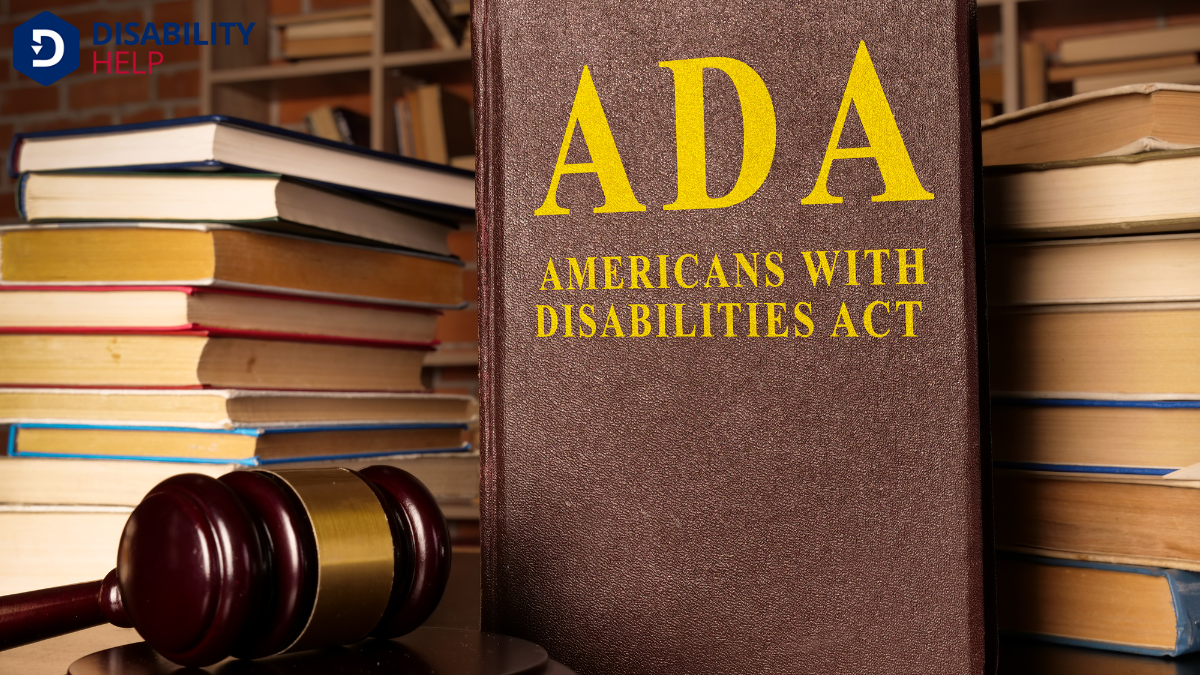Federal employees with disabilities are protected under the Rehabilitation Act of 1973A U.S. law that prohibits discrimination based on disability in federal programs and services, inclu... and the Americans with Disabilities Act. These laws guarantee we aren't discriminated against in employment and have access to reasonable accommodationsModifications or adjustments in healthcare settings to support patients with disabilities. to perform our jobs effectively. From accessible technology to modified work schedules, these measures promote an inclusive environment. By providing equal opportunities and support networks, we encourage everyone to succeed. Stay tuned to discover more about the resources and steps available for federal employees with disabilities.
Key Takeaways
- Section 501 of the RehabilitationThe process of helping individuals with disabilities achieve and maintain their optimal physical, se... Act prohibits discrimination based on disability in federal employment.
- The ADA Title I ensures federal employees are protected from workplace discriminationUnfair treatment of employees based on disability, including hiring, promotion, job assignment, term....
- Federal agencies must provide reasonable accommodations for employees with disabilities.
- Affirmative actionPolicies that promote the employment of individuals from underrepresented groups, including people w... is emphasized to recruit individuals with disabilities into federal roles.
- AccessibilityThe design of products, devices, services, or environments to be usable by people with disabilities.... accommodationAdjustments or modifications provided to individuals with disabilities to ensure equal access and pa... services support federal employees with workplace challenges.
Understanding the Rehabilitation Act of 1973
The Rehabilitation Act of 1973 is a cornerstone in our journey toward guaranteeing equal opportunities for federal employees with disabilities. It was the first major legislation to address discrimination based on disability, setting a precedent for future laws.
We recognize that Section 501 specifically prohibits discrimination in federal employment, requiring agencies to provide reasonable accommodations. This act acknowledges the importance of creating an inclusive environment where everyone can contribute effectively.
We should understand that the act not only mandates non-discrimination but also emphasizes affirmative action. By doing so, it encourages federal agencies to proactively recruit and hire qualified individuals with disabilities.
Let’s continue to guarantee that federal workplaces remain equitable and accessible, reflecting our commitment to diversityThe inclusion of individuals from a wide range of backgrounds, including people with disabilities. and inclusionThe practice of creating environments in which any individual or group can be and feel welcomed, res... for all employees.
Key Provisions of the Americans With Disabilities Act

Building on the foundation laid by the Rehabilitation Act of 1973, the Americans With Disabilities Act (ADA)A U.S. law that prohibits discrimination against individuals with disabilities in all areas of publi... further strengthens protections for individuals with disabilities.
The ADA is essential in guaranteeing equality and accessibility in various aspects of life. Let's explore some key provisions of the ADA to better understand its impact.
- Title I: This provision prohibits discrimination in employment, guaranteeing we all have equal job opportunities.
- Title II: Public entities, like government agencies, must provide access to programs and services.
- Title III: Businesses open to the public must guarantee accessibility, removing barriers for everyone.
- Title IV: Telecommunications companies must provide communication services for those with hearing or speech disabilities.
These provisions empower us to advocate for equal rights and opportunities in our workplaces and communities.
The Role of Reasonable Accommodations in the Workplace
When we consider workplace inclusivity, reasonable accommodations play a crucial role in ensuring employees with disabilities can perform their jobs effectively.
These accommodations can be adjustments or modifications to the work environment or the way a job is typically performed. For instance, providing assistive technology, modifying work schedules, or altering the physical workspace can make a significant difference in an employee's ability to contribute.
It’s essential that we recognize these accommodations aren't just beneficial but necessary for fostering an inclusive and diverse workplace. They empower employees to showcase their skills and contribute fully.
Steps to Request and Obtain Accommodations
How do we guarantee that employees with disabilities receive the support they need to thrive?
We start by understanding and effectively steering the process to request accommodations. It involves clear communication and collaboration between employees and employers. Here’s a guide to help us through:
- Identify Needs: Determine the specific accommodations that will help overcome workplace challenges.
- Notify in Writing: Submit a formal written request to the appropriate department or supervisor.
- Provide Documentation: Be ready to offer documentation from a healthcare provider outlining the disability and needed accommodations.
- Engage in Dialogue: Participate in an interactive process with the employer to explore potential solutions and alternatives.
Legal Recourse for Disability Discrimination

While requesting accommodations is a proactive step, there are times when these efforts mightn't suffice, and employees with disabilities face discrimination. When this happens, understanding our legal recourse is essential.
Under the Rehabilitation Act, federal employees are protected against discrimination and have the right to file a complaint if their rights are violated. We can begin by filing a complaint with the Equal Employment Opportunity (EEO)The principle that all individuals should have equal access to employment opportunities, regardless ... office within our agencyThe capacity of individuals with disabilities to act independently and make their own choices..
If unresolved, we've the option to escalate it to the Equal Employment Opportunity Commission (EEOC). It's important to remember that keeping detailed records of incidents and communications strengthens our case.
Resources and Support for Federal Employees With Disabilities
As federal employees, we've access to various resources that guarantee a supportive work environment for those with disabilities.
Accessibility accommodation services help us navigate our workplace more easily, while disability advocacyEfforts and services aimed at protecting and promoting the rights and interests of individuals with ... programs provide us with the necessary backing to address any concerns.
Additionally, workplace support networks offer a community where we can share experiences and advice.
Accessibility Accommodation Services
Federal employees with disabilities deserve the same opportunities and work environments as their peers, which is why accessibility accommodation services are essential.
These services guarantee that everyone can perform their duties effectively and comfortably. By leveling the playing field, we promote inclusivity and productivity.
Here’s what these services typically include:
- Assistive technology: Tools like screen readers and voice recognition software help individuals with visual or hearing impairments.
- Physical modifications: Adjustments such as ramps, elevators, and ergonomic workstations cater to mobility needs.
- Flexible work arrangementsWork schedules that allow employees with disabilities to manage their health and job responsibilitie...: Options like telework or modified schedules accommodate various health requirements.
- Sign language interpreters: Providing interpreters guarantees clear communication for deaf or hard-of-hearing employees.
Disability Advocacy Programs
Beyond providing accessibility accommodations, we must also focus on empowering federal employees with disabilities through robust advocacyThe act of arguing in favor of, supporting, or defending the rights and interests of individuals or ... programs.
These programs are essential for ensuring that employees not only know their rights but also can effectively communicate their needs within the workplace. By engaging in advocacy, we foster a culture where all voices are heard and valued, enabling us to break down barriers and promote inclusivity.
Advocacy programs should provide training sessions, workshops, and resources that help employees understand their rights under laws like the Rehabilitation Act.
They can also connect individuals with experienced advocates who guide and support them in maneuvering complex workplace dynamics.
Through these efforts, we'll create a more equitable environment where employees with disabilities feel empowered and supported in their professional journeys.
Workplace Support Networks
Although creating an inclusive workplace culture is essential, establishing effective workplace support networks is equally important for federal employees with disabilities.
These networks provide valuable resources and foster a sense of community. Let’s explore some key components:
- Mentorship ProgramsPrograms that pair individuals with disabilities with experienced professionals to provide guidance ...: We can connect with experienced colleagues who offer guidance and share their expertise.
- Employee Resource Groups (ERGs): ERGs unite us, providing platforms to discuss shared experiences and advocate for accessible workplaceA work environment designed to be usable by individuals with disabilities, including physical, techn... practices.
- Access to Accommodations: Ensuring that tools and resources are available helps us perform our duties effectively and comfortably.
- Peer SupportA system where individuals with disabilities provide support and share experiences to help each othe... Systems: Building connections with peers facing similar challenges reinforces our sense of belonging and improves morale.
With these support networks in place, we empower each other, enhancing our productivity and well-being.
Conclusion
In steering the workplace as federal employees with disabilities, we’re empowered by key legislation like the Rehabilitation Act of 1973 and the Americans With Disabilities Act. These laws guarantee our right to reasonable accommodations and protect us against discrimination. By understanding the process to request accommodations and knowing our legal recourse, we can advocate for ourselves. Let’s utilize available resources and support networks to create an inclusive and accessible work environment for everyone.






